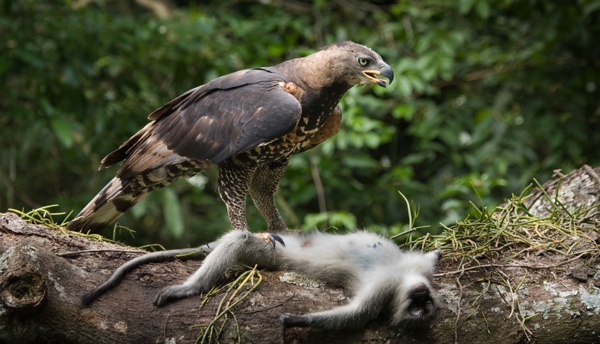African Crowned Eagle
Scientific Name: StephanoaetusDescription:
The Crowned Eagle is the largest and fiercest of all the African eagles, although the wingspan of the Verreauxs Eagle (formerly Black Eagle), Martial Eagle and Tawny Eagle is longer. It is normally considered to be a purely forest eagle, common to Tropical Africa, but it sometimes occurs in more open country as well. In South Africa it is found in the eastern parts as far south as Knysna and as far west as Grootvadersbosch near Heidelberg.
Pictures: Courtesy of South African Tourism!

Size:
Very Large with a height of 80 to 90 cm; Wingspan: 152cm - 209cm.
Area:
In eastern Africa, the Crowned Eagle's range extends from southern Uganda and Kenya, forested parts of Tanzania, eastern Zambia, the Democratic Republic of Congo, Malawi, Zimbabwe, Mozambique, Swaziland and eastern South Africa. Its range also extends westward about as far as Liberia, though its distribution is severely fragmented in these areas. The eagle is less prominent at the extremes of its range, being most populous between Zimbabwe and Tanzania; it is restricted to denser vegetation and forests throughout its distribution. The Crowned Eagle inhabits dense forests (sometimes plantations), heavily wooded hillsides, dense woodland and rocky outcrops throughout its range, at an altitude of up to 11,000 ft. Owing to lack of suitable habitat (through deforestation and industrialisation), the eagle's range is discontinuous.

Habits:
The Crowned Eagle is unfortunately only a mere visitor to the Western Cape and then it is probably a sub-adult, going on what John Martin, a well-known birdwatcher from Somerset West, called, "the grand tour", which all sub-adult eagles do before they settle in their own territory. It might be of interest to note that one nest of a Crowned Eagle in Grahamstown was in use for 75 years. The explanation is that when one of the pair dies the other takes a new mate and so it goes on. Other nests have been in use nearly as long. In Kwazulu Natal the Crowned Eagle is very popular with the sugar farmers. A farm that is lucky to have a resident pair has no problems with Vervet Monkeys. They can do a great deal of damage to sugar cane, but with a pair of Crowned Eagles around they stay inside the forested areas.
Nesting:
The nest is a very big structure of sticks in a large tree. It is used for many years and is added to every breeding season. They sometimes have a second nest used alternately, when the prey in the area near the first nest gets scarce. The nests may be up to 15 or 20 km apart. The eagle normally lays two eggs, sometimes only one, but the first chick to hatch will always kill the second one. The nestling period is very long, almost 114 days. After that the chick remains with the parents until the next breeding season, which may be for a period of up to two years. It then goes off on its own without aggression from the parents, as is the case with some other eagles. Crowned Eagle pairs breed once every two years; a single breeding cycle is approximately 500 days in duration. The pair collaborates in building a massive nest in a fork of a large forest tree, typically 15 to 40 m above the ground. A nest built from scratch may take several 5) months to construct, however existing nests are often repaired and re-used during successive breeding seasons. A larger nest may measure up to 2.5 m across and up to 3 m deep and consists of both dead and greener branches.

Food:
The prey of crowned eagles varies according to the habitat. In thick forest areas they take mainly vervet monkeys; in more open forest they take Blue Duiker, Forest Duiker and even occasionally Bushbuck which could weigh up to 17 kg. The killing is almost always instantaneous. They grab hold of the head of the antelope or monkey with their talons, then the three centimetre long claw on the back toe is forced into the brain of the animal, killing it instantly. The skulls of about fifty animals, monkeys, antelope, dassies, etc were collected at a number of nests by a researcher. All had the telltale hole in the back of the skull. The Crowned Eagle just cannot afford to have a long fight with any animal heavier than itself (a male Crowned Eagle only weighs about 4,5 kg). The hunting technique is very interesting. The birds work together. The female flies low over the trees when vervet monkeys are gathered. The monkeys then all scamper up to the tops of the trees. The male in the meantime has approached from below the canopy. The bird shoots up from below and grabs a monkey, then kills it in flight. He then brings it to the perch, usually a rock or dead tree, to pluck the hair off the stomach area to start eating. We got hold of a large monkey which had been killed (a risky business) it weighed 7 kg, much heavier than the bird itself. Antelope and other small animals are killed on the forest floor.






